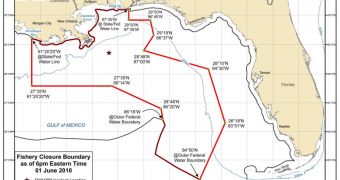The US National Oceanic and Atmospheric Administration (NOAA) announces that it has just expanded the area of the Gulf of Mexico that is forbidden for fishermen. Officials at the agency say in a statement that the decision was taken because the situation is spiraling out of control, as oil slicks move in all directions away from the original site of the accident. Between 12,000 and 19,000 barrels of oil are leaking into the water each day, according to the latest estimates.
“NOAA has extended the northern and southern boundaries of the closed fishing area in the Gulf of Mexico to capture portions of the slick moving into waters off eastern Alabama and the western tip of the Florida panhandle, as well as some large patches of sheen moving onto the west Florida shelf and southward to Cuban waters. This federal closure does not apply to any state waters. Closing fishing in these areas is a precautionary measure to ensure that seafood from the Gulf will remain safe for consumers,” the Administration announces in its press release.
According to new data, it would appear that about 31 percent of the federal waters in the Gulf are currently closed for fishing. This represents a total of about 75,920 square miles, or 196,633 square kilometers. The new decision leaves only 68 percent of federally-controlled waters opened for fishing, and represents an extension from the 61,854 square miles area that was closed down on Monday, May 31. “This extension of the federal fishing closed area due to the Deepwater Horizon/BP oil spill coincides with the June 1 opening of the Gulf of Mexico recreational red snapper season, and will affect some areas targeted by charter boat captains and private anglers,” NOAA officials add.
“The federal and state governments have systems in place to test and monitor seafood safety, prohibit harvesting from affected areas, and keep oiled products out of the marketplace. NOAA continues to work closely with the US Food and Drug Administration [FDA] and the states to ensure seafood safety, by closing fishing areas where tainted seafood could potentially be caught, and assessing whether seafood is tainted or contaminated to levels that pose a risk to human health. NOAA and FDA are working to implement a broad-scaled seafood sampling plan. The plan includes sampling seafood from inside and outside the closure area, as well as dockside- and market-based sampling,” the statement concludes.

 14 DAY TRIAL //
14 DAY TRIAL //